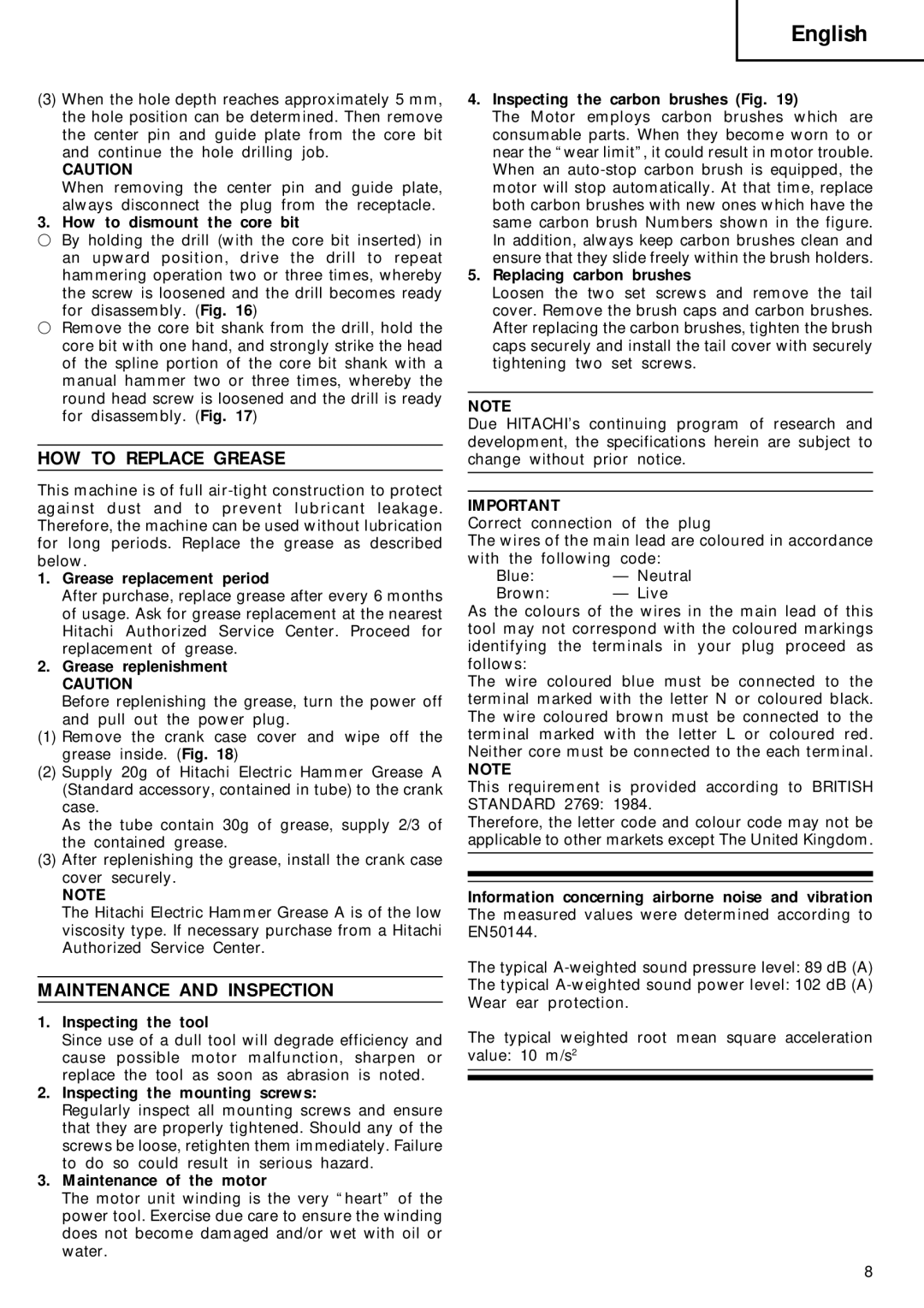
English
(3)When the hole depth reaches approximately 5 mm, the hole position can be determined. Then remove the center pin and guide plate from the core bit and continue the hole drilling job.
CAUTION
When removing the center pin and guide plate,
always disconnect the plug from the receptacle.
3. How to dismount the core bit
◯By holding the drill (with the core bit inserted) in an upward position, drive the drill to repeat hammering operation two or three times, whereby the screw is loosened and the drill becomes ready for disassembly. (Fig. 16)
◯Remove the core bit shank from the drill, hold the core bit with one hand, and strongly strike the head of the spline portion of the core bit shank with a manual hammer two or three times, whereby the round head screw is loosened and the drill is ready for disassembly. (Fig. 17)
HOW TO REPLACE GREASE
This machine is of full
1.Grease replacement period
After purchase, replace grease after every 6 months of usage. Ask for grease replacement at the nearest Hitachi Authorized Service Center. Proceed for replacement of grease.
2.Grease replenishment
CAUTION
Before replenishing the grease, turn the power off
and pull out the power plug.
(1)Remove the crank case cover and wipe off the grease inside. (Fig. 18)
(2)Supply 20g of Hitachi Electric Hammer Grease A (Standard accessory, contained in tube) to the crank case.
As the tube contain 30g of grease, supply 2/3 of the contained grease.
(3)After replenishing the grease, install the crank case cover securely.
NOTE
The Hitachi Electric Hammer Grease A is of the low viscosity type. If necessary purchase from a Hitachi Authorized Service Center.
MAINTENANCE AND INSPECTION
1.Inspecting the tool
Since use of a dull tool will degrade efficiency and cause possible motor malfunction, sharpen or replace the tool as soon as abrasion is noted.
2.Inspecting the mounting screws:
Regularly inspect all mounting screws and ensure that they are properly tightened. Should any of the screws be loose, retighten them immediately. Failure to do so could result in serious hazard.
3.Maintenance of the motor
The motor unit winding is the very “heart” of the power tool. Exercise due care to ensure the winding does not become damaged and/or wet with oil or water.
4.Inspecting the carbon brushes (Fig. 19)
The Motor employs carbon brushes which are consumable parts. When they become worn to or near the “wear limit”, it could result in motor trouble. When an
5.Replacing carbon brushes
Loosen the two set screws and remove the tail cover. Remove the brush caps and carbon brushes. After replacing the carbon brushes, tighten the brush caps securely and install the tail cover with securely tightening two set screws.
NOTE
Due HITACHI’s continuing program of research and development, the specifications herein are subject to change without prior notice.
IMPORTANT
Correct connection of the plug
The wires of the main lead are coloured in accordance
with the following | code: |
Blue: | — Neutral |
Brown: | — Live |
As the colours of the wires in the main lead of this tool may not correspond with the coloured markings identifying the terminals in your plug proceed as follows:
The wire coloured blue must be connected to the terminal marked with the letter N or coloured black. The wire coloured brown must be connected to the terminal marked with the letter L or coloured red. Neither core must be connected to the each terminal.
NOTE
This requirement is provided according to BRITISH STANDARD 2769: 1984.
Therefore, the letter code and colour code may not be applicable to other markets except The United Kingdom.
Information concerning airborne noise and vibration The measured values were determined according to EN50144.
The typical
The typical
The typical weighted root mean square acceleration value: 10 m/s2
8
